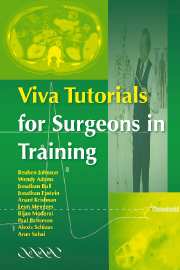2 - Operative Surgery
Published online by Cambridge University Press: 12 August 2009
Summary
HEAD AND NECK
Salivary Glands
What important structures lie within the parotid gland?
Facial nerve.
Retro-mandibular vein.
External carotid artery – bifurcating into its two terminal branches, the maxillary artery and the superficial temporal artery.
Can you outline the surface markings of the parotid gland for?
Using a marker begin a line from in front of the tragus of the ear and draw it into the middle of the cheek below the zygomatic arch. From here proceed downwards and backwards to a point 1 cm in front of the angle of the mandible. Then continue upwards and backwards 1–2 cm into the neck including the mastoid process. Finally draw your line around the ear to join up to the point from where we started. You will now have drawn a shape that approximates the position of the parotid.
What are the potential complications of parotid surgery?
Facial nerve damage.
Haematoma.
Frey's syndrome (gustatory sweating).
Numbness of the pinna (due to sacrifice of the greater auricular nerve).
Salivary fistula (in superficial parotidectomy only, as the cut gland left behind continues to secrete saliva).
Wound dimple.
During surgery how would you locate the facial nerve?
This can be done in three different ways:
by identifying the tip of the tragal cartilage with during the dissection – the facial nerve lies 1 cm inferior and deep to this cartilage;
[…]
- Type
- Chapter
- Information
- Viva Tutorials for Surgeons in Training , pp. 53 - 96Publisher: Cambridge University PressPrint publication year: 2004



